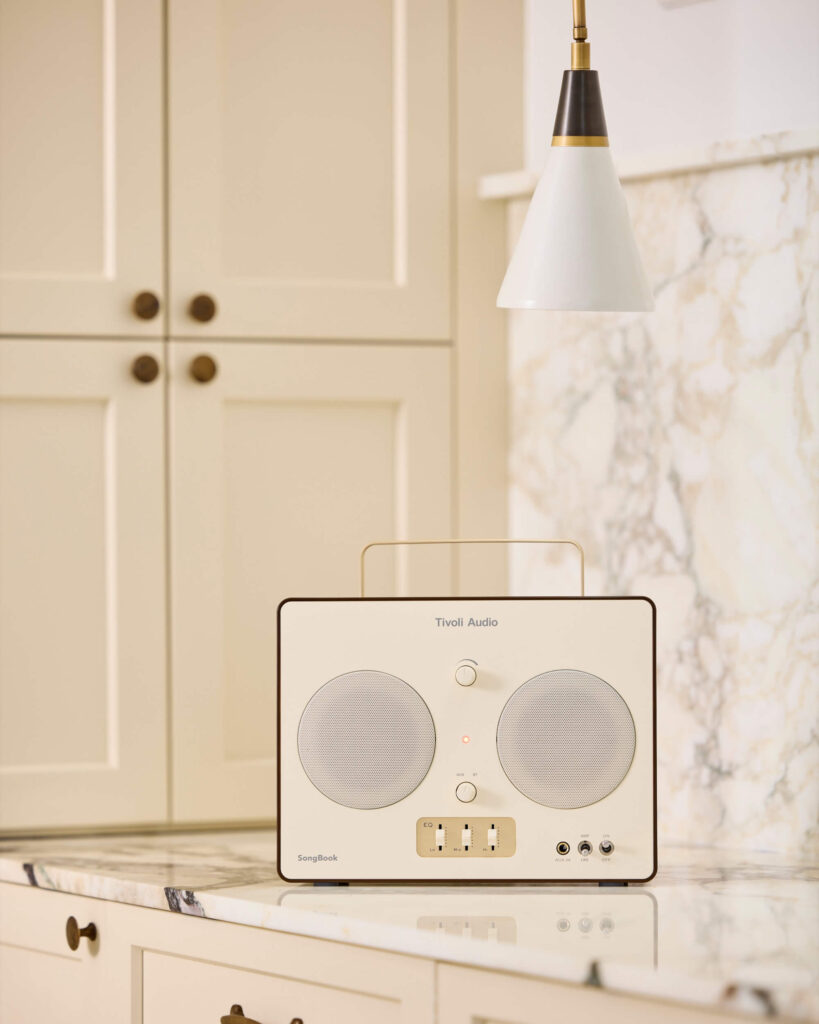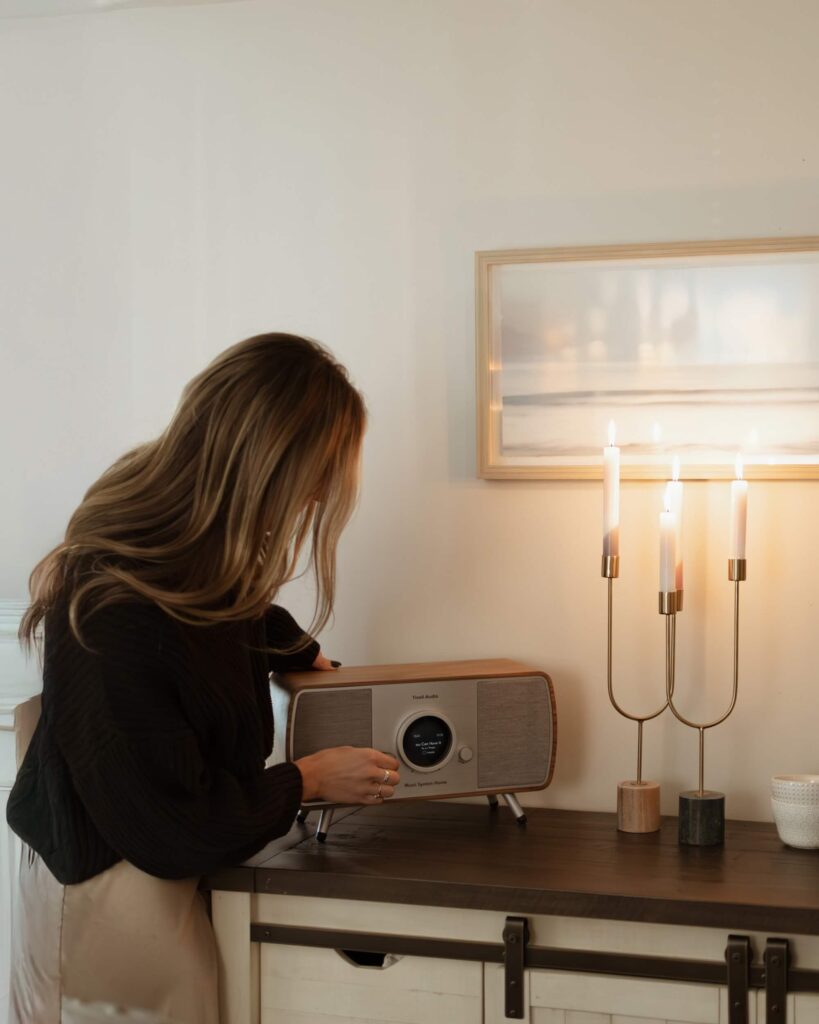This story originally appeared on the Gents Cafe Newsletter. You can subscribe here.
There was a time when speakers were part of the furniture, proud, sculptural, and full of character. They created a world around music: design and sound existed together, inviting people to gather, to listen, to share.
For Paul DePasquale, CEO of Tivoli Audio, that spirit of togetherness remains the brand’s driving force. What began as childhood dance lessons and garage-band dreams evolved into a life devoted to restoring that lost connection between craft and sound. Under his leadership, Tivoli has stayed true to the beauty of analog while embracing innovation, creating objects that are as much a part of the home as the music itself.
In this Brand Talks interview, Paul reflects on his journey from musician to maker, and how Tivoli Audio continues to design products that make music feel communal, tactile, and deeply human.

You grew up in a musical family and mastered several instruments early on. Do you remember a particular moment from your childhood when you realized music would always play a central role in your life?
Absolutely. Even before I picked up any instruments, I was a dancer. Both my parents and my sister were musical, so there was always music in the house. I don’t actually remember this myself, but my mom loves to tell the story: she used to leave me in a playpen with MTV on, and whenever a music video came on—especially Michael Jackson—I would try to climb out, tumble onto the floor, and just start dancing in the middle of the room.
I started dance lessons when I was about four, and I think even at that age I knew music was something that moved me deeply. Not long after that I started playing instruments; first bass and drums, then, as I got older, I picked up the guitar and got into songwriting. That’s when it really clicked that music wasn’t just a childhood hobby: it was going to be a defining part of my life.
I never imagined I’d end up doing what I do now at Tivoli. Back then, I wanted to be a musician—a rock star, honestly. I was in bands, writing songs, recording albums, touring. From about 16 to nearly 30, that was my life. Even when I started working at Tivoli, it was just a day job. Nights and weekends, as well as all my money and energy, still went into trying to make it as a musician.
Looking back, I don’t have regrets. Sure, like anyone with a childhood dream, you sometimes wonder “did I walk away from it too soon? What if things had gone differently?”, But what I’ve experienced at Tivoli—the business challenges, the personal growth—I don’t think I would have learned any of that in the music world.
And in a funny way, I still feel like I’m living a version of that dream. I travel from city to city, hotel to hotel. I share music with people, not by performing it, but by giving them the device to enjoy it. So I joke with my mom: I’m kind of living like a rock star. I’m just selling the music box instead of playing the music.

You’ve been with Tivoli Audio for nearly two decades, rising from customer service to CEO. How has walking through all those chapters influenced your leadership style, and how have you grown as a person along the way?
For the first half of my time at Tivoli I worked in customer service, then gradually moved into engineering and technical product work, and eventually into sales. Back then, the company operated very differently. We were new to the market, so even though we were having a lot of early success, it was still a small and evolving business. I went through all the typical challenges of entry-level roles: tough lessons, growing pains, managing expectations, wanting more responsibility, better pay, or new opportunities. There were moments when I seriously considered leaving to go back to music because I wasn’t sure this was the path I wanted for my life.
But every time I moved from one role to the next, I left it feeling fulfilled, knowing I had done my best. I always tried to work with integrity and never gave anyone a reason to doubt me. At the time, I didn’t fully understand it, but looking back now, I realize that a lot of that drive came from feeling like I had something to prove. I didn’t come from the business world. I didn’t go to business school or set out to become a CEO. So I felt I had to earn my place.
Those years shaped who I am. Over time, I discovered I actually had a natural connection to certain parts of the business. I loved talking about the brand, the music, the design. And that passion became part of my identity here, so much so that today, when I lead our teams in marketing or product, I don’t speak as “the boss.” I speak as someone who cares deeply about this company and what it has given me, both professionally and personally.
And thanks to my unusual path, when someone joins in an entry-level role, I never see them as “just the person in the mailroom.” I see them as someone who could be doing what I’m doing 10 or 15 years from now. I was given the opportunity and the space to grow, and I take it seriously that I should pay that forward. I don’t take any of it for granted.

Tivoli began as a radio company. How do you honor that legacy while guiding the brand into a broader lifestyle identity?
Being known as a radio company has come with both challenges and advantages. Today, many people say, “Who still listens to the radio?” With streaming and digital platforms everywhere, it’s a fair question. Yet we still sell hundreds of thousands of radios worldwide. And to me, the legacy isn’t really about radio itself: it’s about what our first product, the Model One, represented.
Besides sounding great and looking beautiful, it embodied simplicity and represented an easy, almost nostalgic way of enjoying time and music. Turning a dial, adjusting the volume, tuning into a station, all happened through a tactile, immediate experience that is deeply human. That feeling is what we’ve always tried to bottle, no matter what product we make.
So as we moved from radios to CD players, alarm clocks, Bluetooth speakers, and portable products, the core identity remained the same: simple, approachable, high-quality objects that bring uncomplicated enjoyment. You should never have to wonder what it does or how to use it.
There was a time, especially when streaming and app-based culture became mainstream, that I thought it could be the end of analog products. But we found a way to bring modern technology into our designs while keeping that same organic, human interaction. And we’ve also stayed committed to producing purely analog products alongside the connected ones.
What’s been fascinating is the response from younger generations. Unlike my generation, which was captivated by new technology because we didn’t grow up with it, younger people have only ever known digital life—phones, social media, touchscreens. So when they see a Model One, a turntable, or any analog device, they’re curious. Their eyes light up. They can touch it, turn a dial, feel the mechanism respond. There’s an action and a reaction. It’s real, not virtual, and that’s inherently engaging.
One moment that really reassured me was at a friend’s house with a five or six year old boy. He only knew electronic music and digital DJs. I plugged in a guitar to an amplifier, hit one big distorted chord, and his eyes just lit up like he had witnessed magic. That moment made me realize: the desire for something physical, analog, and real isn’t going away. If anything, this new generation might be the one to bring it back.

Looking back, which three products best capture Tivoli’s story and evolution over the years?
The first product has to be the Model One. It’s where everything began and still represents the DNA of Tivoli through design, sound quality, simplicity, and ease of use. Every product we’ve made since then carries a piece of that original philosophy in one way or another.
For over fifteen years we continued to evolve the Model One, including versions like the Model One BT. But a major turning point came in 2016 with the Model One Digital. That was the moment we fully stepped into a more technical era. We kept everything we loved about the original—especially the tactile experience of the dial and volume knob—but added a modern “brain”: Spotify, AirPlay, Google Cast, DAB, FM, Bluetooth. It was our way of saying, we can innovate and still preserve the soul of analog. It was a big internal moment for us, proving we could grow without losing our identity.
The third product I’d choose is the SongBook. Originally, back in the mid-2000s, it was a small portable travel radio with Bluetooth and batteries—a beloved product at the time. We discontinued it eventually, but recently brought it back in a completely reimagined form. The new SongBook is larger, intentionally more analog in appearance and interaction, almost a return to basics. The goal was to create something that performs like a hi-fi system but still feels warm, tactile, and human, allowing to use the radio or Bluetooth without feeling overly technical or sterile.

Wallpaper once named you among designers making a visual impact in audio. How do you define the idea of a “visual language of sound”?
When I studied music and audio engineering in college, I started to notice a shift: people were focusing more on the visual representation of sound (the waveform on a computer screen) rather than simply listening. In the past, engineers relied on their ears and a few basic meters. But with digital recording, sound became something you see. Even early iTunes had visualizers people would stare at while listening to music. That was the moment I realized music alone might not be enough anymore: people also wanted a visual experience.
So at Tivoli, while sound and simplicity were always core values, design became the element that truly set us apart. Over the years, I felt that people stopped caring about how they listened to music: speakers became hidden, anonymous black or silver boxes shoved into corners. They were treated as purely functional, with no identity.
But I’ve always loved analog gear like old speakers, instruments, and turntables, because they didn’t just play music, they created a world around it. Italian, German, Japanese, American designers all understood this: good design invites you in before a single note plays.
I’ve always loved analog gear like old speakers, instruments, and turntables, because they didn’t just play music, they created a world around it. Italian, German, Japanese, American designers all understood this: good design invites you in before a single note plays.
That’s what I mean by a “visual language of sound.” The design of an audio product should encourage people to listen, to gather, to make music communal again. A beautiful object can spark a conversation: “What’s that?” and suddenly people are sitting together, enjoying music rather than consuming it passively or alone.
It’s no different from when CDs came with booklets filled with lyrics, artwork, and stories. That visual component deepened the listening experience, in a way streaming often doesn’t. Today, an incredible 87% of music is listened to through earbuds. I use them too for calls, commuting, working out, but it still worries me. Music isn’t meant to exist only in private. It’s meant to be shared.
You’ve also said Tivoli’s products are “much more than gadgets.” In your view, what transforms a piece of audio equipment into a true statement of craft and culture?
Today it’s incredibly easy to go to a factory, pick something off the shelf, put your logo on it, and sell it. You see a lot of that, especially online: cheap, gadgety products that might work for a while, then break and get thrown away.
Our philosophy has always been the opposite: stay true to craft. Take the harder path. Pay attention to every detail, inside and out. Make something that feels special, not just in what it does, but in what it is. To me, a gadget is purely about function. It might be plastic, feel disposable, and all the investment goes into the feature, not the form. Craft is when you care equally about both the performance and the experience, the technology and the materials.
That’s how an object becomes more than a gadget. It becomes part of someone’s home, their routine, their memories. And we take responsibility for that. All our products are built to last and, just as importantly, to be repairable. If something breaks, we try to fix it, whether it’s software or hardware. And even if it’s long out of warranty and we truly can’t repair it, we’ll still offer a replacement at a very low cost, sometimes even 50% off, just to show our appreciation. Because if people invest in us, we have to invest in them. It’s that simple.

You’ve described Tivoli products as “a reflection of the global connection we have as humans.” What does that connection mean to you when translated into sound?
The connection to sound and music is one of the most primal things we share. Before lyrics, before language, there was rhythm, bass, heartbeat. You don’t need to understand the words of a song to feel it. Whether it’s joy, sadness, excitement, or fear, raw emotion is universal.
Music is one of those rare things that transcends culture and language. No matter where you go in the world, people understand it instinctively. It brings people together, just like a shared meal or a great film or sporting moment. Those are the things that unify us as humans.
Music is one of those rare things that transcends culture and language. No matter where you go in the world, people understand it instinctively. It brings people together, just like a shared meal or a great film or sporting moment. Those are the things that unify us as humans.
That understanding is core to how we design at Tivoli. We sell in over 30 countries—Japan, across Europe, the Nordics, Southeast Asia, Australia, the U.S., Canada—and every market has its own cultural preferences. But rather than focusing on the differences first, we start with what connects us: music, emotion, simplicity, beauty.
So when we design a product looking into its sound, its shape, its interface, even its color someone will inevitably say, “This might work in Japan but not in the U.S.,” or “The Nordics will love this but maybe not Southern Europe.” And that’s when we push ourselves further and ask: How do we make something that resonates everywhere? Something rooted in that shared global connection.
You’ve described music as a universal language, capable of driving change. How did that belief take shape in Tivoli Together, and what led you to feel the company should actively engage in social and environmental causes?
Tivoli Together really began during COVID. There was a moment when I personally started questioning what it means to be a manufacturer, because manufacturing, by nature, has a negative impact. It creates waste, uses resources, and often produces things people want, but not necessarily need. And in a time when millions were sick or losing their lives, it felt strange to say, “Hey, buy this radio.” Sure, we had to keep the business going, but it sparked something deeper in me.
I used to think that getting involved in social or environmental causes meant a big financial burden, and I think a lot of companies feel the same: becoming more sustainable or socially responsible sounds expensive. But then I realized we already have a platform. We’re in over 30 countries, we have strong brand awareness, global partners, and a loyal audience. Even if we couldn’t fix everything, we could use our voice and our products to raise awareness, support causes, and try to do some good.
We started small, but gradually integrated different actions. On our U.S. website, customers can now choose to donate part of their purchase to one of five organizations we support. As a company, we volunteer, participate in community services, and support local initiatives and fundraisers. We picked causes we care about, from human rights and environmental protection to education, animal welfare, and access to music for kids from under-resourced communities. We keep evolving the program depending on where we feel we can make the most impact.
On the product side, we focused on reducing waste. Packaging was the first major change: we steered away from plastics, opting for just recyclable or biodegradable materials. The bags are made from cornstarch, the old styrofoam trays are now molded pulp from recycled paper, and we’ve moved many manuals and inserts to digital QR codes to cut down paper use.
We also changed how we source materials. Our wood is FSC-certified, meaning it comes from responsibly managed forests. We’ve removed harmful chemicals from plastics and eliminated materials that are toxic to people or the planet. We’re not perfect, because manufacturing will always have an impact, but we’re committed to being mindful and always improving.

You continue to compose under aliases like Headfoam and Ghost On TV. In what ways does maintaining that creative outlet feed back into your perspective as a leader at Tivoli?
For a while, around 2015 to 2020, I put music on hold to focus fully on Tivoli and the responsibility of being CEO. But I eventually learned the hard way that burnout is real. You can work endlessly, but if you lose your energy and creativity, your work suffers no matter how many hours you put in.
That’s what brought me back to making music. At first, I resisted it because I wasn’t touring, promoting it, or trying to make a living from it like I used to. So I asked myself, What’s the point? But I eventually realized it doesn’t need a point. It’s art. You create because it feeds something in you.
Now I write and record at home, sometimes as Headfoam, sometimes as Ghost On TV and I put it out there. Maybe people listen, maybe they don’t. That’s not the goal anymore. The goal is the process. When I spend a weekend writing something I’m proud of, and I listen back to it on Monday morning, I walk into work feeling energized, inspired, and creatively awake.
That spills directly into how I lead Tivoli. Even if I’m not designing a product myself, I’m solving problems with a fresh mindset. I feel more innovative, more open, more resilient. Creating music reminds me that I am still creative and that belief makes me a better leader.
I also try to pass this on to the team. When I see someone losing themselves to the grind, I’ll tell them: take the afternoon, go do something you love, reset. Come back tomorrow with a clearer head. Because it’s not just about working harder—it’s about protecting the part of yourself that makes the work meaningful.
I also try to pass this on to the team. When I see someone losing themselves to the grind, I’ll tell them: take the afternoon, go do something you love, reset. Come back tomorrow with a clearer head. Because it’s not just about working harder—it’s about protecting the part of yourself that makes the work meaningful.
Beyond Tivoli and your music, what other passions drive you, and how do they shape the way you live and create?
I have a deep love for movies and all forms of art and culture. I enjoy learning about different cultures and I think art, film, and even food are a great way to get in touch with them. Sports are another outlet for me—I’m a fan of basketball, hockey, and soccer, and I use them sometimes as a way to step away and recharge.
Fashion has also always been a passion. I’ve often thought that if I hadn’t pursued music and Tivoli, I might have ended up in the fashion world. Beyond that, I really enjoy the culture around coffee, tea, cocktails, and craft brewing. I love the craft behind it all. I’ve even made beers and limoncello myself, which connects back to my family roots in southern Italy.









